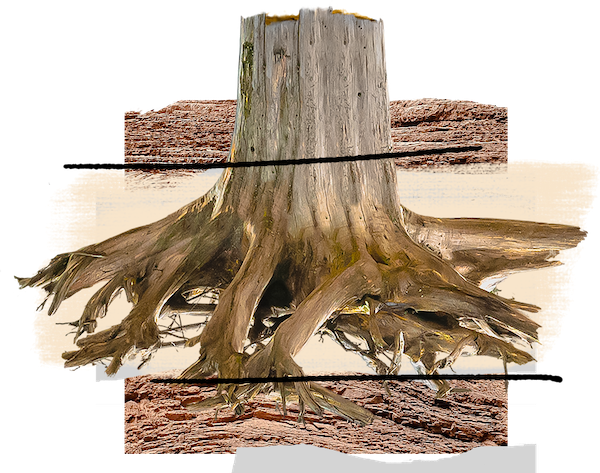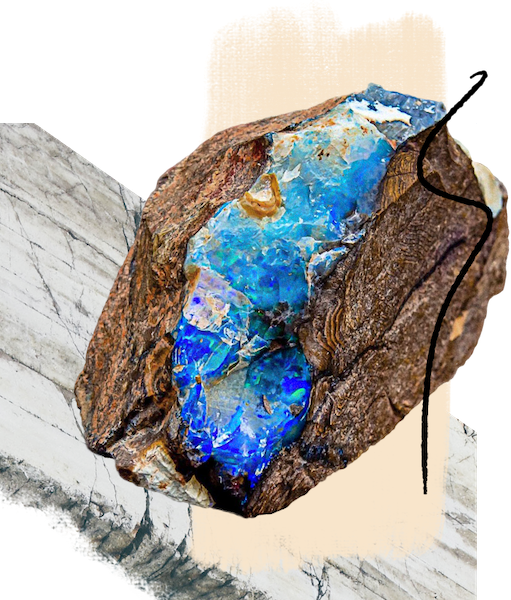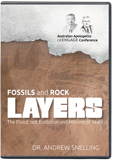Faster Than You Think
Life comes at you fast. In just the last 50 years, we’ve seen many amazing technological advances: mobile phones, electronic communication, personal computers, the internet, artificial intelligence—the list goes on. Like technology, many things we see around us have developed faster than we might imagine possible.
However, we often hear that the earth and the materials in the earth, such as oil and coal, came into being by natural processes that occurred over millions of years.
When we look at the data without interpreting it through an evolutionary worldview, we understand that there’s no reason not to trust the plain reading of God’s Word which says our world began roughly 6,000 years ago. Starting with that biblical worldview, let’s look at six processes that happened much faster than you might think.
1. Fast Fossils

For many people, the idea of evolution occurring over vast ages is literally rock solid, proven by the number of fossilized creatures entombed in sediments around the world.
However, with new research, evolutionists admit fossils can form incredibly fast. According to Canadian paleontologist and evolutionist Dr. Phil Currie, “The amount of time that it takes for a bone to become completely permineralized is highly variable. If the groundwater is heavily laden with minerals in solution, the process can happen rapidly.”1 Rapidly indeed! In a 2018 study by the University of Bristol, researchers created fossils in just 24 hours using a hydraulic press. The scientists stated that the synthetic fossils “closely resemble exceptional fossils, not just visually, but also microscopically.”2
Fossils can form rapidly under the right conditions, such as the conditions of the global flood that God used to judge a sin-filled world around 4,300 years ago (Genesis 6–9).
2. Sudden Sediments

Rock layers can form very quicky. We see evidence of this rapid formation in the remains of trees and plants extending through multiple layers of sediments, such as the fossilized vertical tree stumps found in the cliffs in Joggins, Nova Scotia. These fossils extend through rock layers that most evolutionists would say accumulated over hundreds of thousands to millions of years. But dead trees don’t stand around for thousands of years waiting to be buried.
Generally, dead trees dry out at the top, rot out at the bottom, topple over after a short time, and get devoured by decomposers. So to find them standing upright, with little to no signs of decomposition, suggests they were buried and fossilized very rapidly. The signs of their rapid fossilization means that the meters of rock surrounding them must have formed simultaneously.
After studying evidence from before and after Mount St. Helens erupted, geologists observed that stratified rock (layers of rock formed over time) can accumulate in very short periods during catastrophic conditions. In one area, 25 feet (7.6 meters) of stratified deposit accumulated and hardened within three hours.3
3. Rapid Refinery

Most people believe that oil and natural gas take millions of years to form as layers of decomposing plants and animals endure intense heat from earth and pressure from rocks. But numerous studies have demonstrated that oil can be produced in days by converting sewage,4 and natural gas can be formed in a few years by heating coal.5 Critics have dismissed these studies for not being purely natural processes, and, therefore, not equated with the processes that created “real” oil.
However, back in 1982, a New York Times article titled “Divers Find Natural ‘Oil Refineries’” stated, “Oil is being formed [in the Gulf of California] from the unusually rapid breakdown of organic debris by extraordinarily extensive heat flowing through the sediments, offering scientists a singular opportunity to see how petroleum is formed. . . . Ordinarily oil has been thought to form over millions of years whereas in this instance the process is probably occurring in thousands of years.”6 For decades, oil has formed rapidly under common geological conditions.7
4. Gems in a Jiffy

Few countries know gems like Australia, the supplier of nearly 95% of the world’s opals. According to the company Gemstory Australia, “It takes about 5 to 6 million years to make a 1 cm opal to mature.”8
Dazzling opals form when water running through silica-rich sandstone layers carries silica into cracks and crannies. When the water evaporates, it leaves behind a solution of silicon dioxide and water, the ingredients for opals. Evolutionists believe this process happens very slowly over millions of years. But try telling that to Len Cram, an Aussie in New South Wales who grows opals in weeks. Cram, who holds a PhD and wrote a thesis on opal research, is likely one of the world’s leading authorities on opals. In fact, the opals he produces are indistinguishable from opals dug out of local mines that sell for hundreds of dollars.9,10
Opals aren’t the only precious gem to be produced quickly. Recent research found that naturally forming emerald and tourmaline likely grew in just a few hours!11
5. Quick Coal Accumulation
Some modern evolutionary coal geologists concede that specific coal deposits are better explained as deposited by flood. But is there observational evidence that suggests all coal beds around the world might have been created quickly?
The 20-megaton blast from Mount St. Helens devastated approximately 230 square miles (600 sq. km) almost instantaneously. Many 195-feet-tall (60 m) Douglas fir trees were blown off their stumps and stripped of their branches, and up to a million logs fell into Spirit Lake beside the volcano. Because their root ends were thicker and denser, many logs floated upright.

During subsequent years, an estimated 20,000 logs sank to the lake floor, many of them upright. Five years after the initial eruption, scuba divers and radar equipment confirmed many logs were buried over 3.3 feet (1 m) deep. The remaining trees on the surface formed a gigantic floating mat, constantly bobbing and banging into one another, causing them to shed their bark and branches.
The falling sheets of bark, branches, and root materials intermingled with volcanic sediments. In just a few years, these components formed a layer of peat more than 3 feet (1 meter) thick, with a coarse texture and a layered appearance looking like other coal beds found in the eastern US.12
Coal beds can form rapidly during catastrophic deforestation events. The great Genesis flood would have destroyed the earth’s forests very quickly, resulting in huge log mats that would have supplied tons of bark, branches, and other woody matter that sank and provided the raw materials to form earth’s coal layers.
6. Speedy Speciation

Long before discovering details regarding DNA or epigenetics, creationists promoted the idea of rapid speciation. They realized that there must be genetic mechanisms that could allow creatures to adapt and change in response to their environment over short periods of time. Rapid speciation accounts for how the relatively small number of animal kinds that got off the ark about 4,300 years ago could have diversified into the millions of variations (species) we see today.
Most early Darwinists assumed new species would take vast periods of time to develop; however, rapid speciation has recently been observed in a variety of creatures, including Darwin’s finches. In fact, a 2017 study found that a new species of finches formed in just two generations.13
Of course, speciation is not evolution, because what we observe is kinds of creatures diversifying into variations of the same kind over a short period of time using pre-existing genetics. Finches turn into finches. Moths into another variation of moths. Speedy speciation is now accepted as common—many just call it evolution.
Adapted from Calvin Smith’s blog, “Need for Speed,” July 19, 2021, https://answersingenesis.org/blogs/calvin-smith/2021/07/19/need-for-speed/.
Answers Magazine
October–December 2023
The Rocky Mountains are a majestic reminder of God’s past judgment and future promise.
Browse Issue SubscribeFootnotes
- P. J. Currie and E. B. Koppelhus, 101 Questions about Dinosaurs, (Mineola, NY: Dover Publications, 1996), 11.
- University of Bristol, “Creating ‘Synthetic’ Fossils in the Lab Sheds Light on Fossilisation Processes,” University of Bristol, November 20, 2018, https://www.bristol.ac.uk/news/2018/july/creating-synthetic-fossils.html.
- Steve Austin, “Why Is Mount St. Helens Important to the Origins Controversy?,” The New Answers Book 3 (Green Forest, AR: Master Books, 2010), 255.
- Susan Bauer, James Oyler, Don Bradley, and Carrie Capuco, “Fuel from Sewage Is the Future – and It’s Closer than You Think,” PNNL, October 1, 2017, https://www.pnnl.gov/news/release.aspx?id=4317.
- J. D. Saxby and K. W. Riley, “Petroleum Generation by Laboratory-Scaled Pyrolysis over Six Years Simulating Conditions in a Subsiding Basin,” 1984, Nature, vol. 308, pp. 177–179.
- Walter Sullivan, “Divers Find Natural ‘Oil Refineries,’” The New York Times, January 29, 1982, https://www.nytimes.com/1982/01/29/us/divers-find-natural-oil-refineries.html.
- For further reading, see Dr. Andrew A. Snelling, “How Fast Can Oil Form?,” Answers in Genesis, March 1, 1990, https://answersingenesis.org/geology/catastrophism/how-fast-can-oil-form/ and Dr. Andrew A. Snelling, “The Origin of Oil,” Answers, January 2007, 74–76.
- Gemstory, “How Opal Is Formed,” 2003, http://www.gemstory.com.au/advanced1-how-opal-is-formed.html#opal6.
- Patrick R. Phelps, Cin-Ty A. Lee, and Douglas M. Morton, “Episodes of Fast Crystal Growth in Pegmatites,” Nature Communications, 2020, https://www.nature.com/articles/s41467-020-18806-w.
- For further reading, see Dr. Andrew A. Snelling, “Growing Opals—Australian Style,” Answers in Genesis, December 1, 1989, https://answersingenesis.org/geology/rocks-and-minerals/growing-opals-australian-style/ and Dr. Andrew A. Snelling, “Rapid Opals in the Outback,” Answers, July 2014, 46.
- For further reading, see Dr. Andrew A. Snelling, “Large Gem Crystals Grew within Hours: Consistent with Rapid Granite Formation on a Young Earth,” Answers in Genesis, November 3, 2020, https://answersingenesis.org/geology/large-gem-crystals-grew-within-hours/.
- For further reading, see Dr. Andrew A. Snelling, Dr. Joe Francis, Tom Hennigan, “Lasting Lessons from Mount St. Helens,” Answers, April 2015, 56, and Dr. Andrew A. Snelling, “Four Lessons From the Mount St. Helens Eruption,” Answers in Depth, May 18, 2020, https://answersingenesis.org/geology/four-lessons-mount-st-helens-eruption/.
- Princeton University, “Galapagos Study Finds That New Species Can Develop in as Little as Two Generations.” Phys.org, November 23, 2017, https://phys.org/news/2017-11-galapagos-species.html.
Recommended Resources

Answers in Genesis is an apologetics ministry, dedicated to helping Christians defend their faith and proclaim the good news of Jesus Christ.
- Customer Service 800.778.3390
- © 2024 Answers in Genesis







